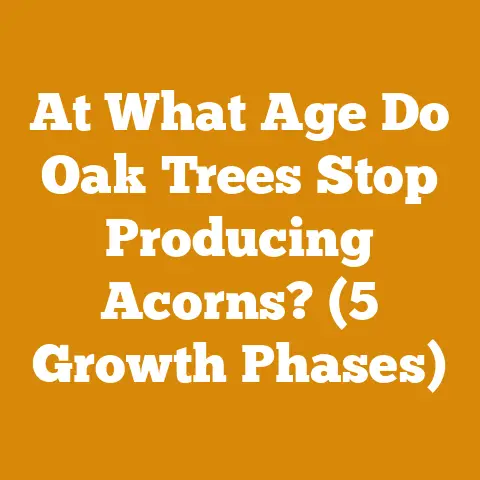Growing Apple Trees from Cuttings (5 Expert Grafting Tips)
Introduction: Eco-Tech Grafting for Sustainable Apple Orchards
The world of apple cultivation is undergoing a quiet revolution, driven by eco-conscious techniques that maximize yield while minimizing environmental impact. Grafting, an age-old practice, is at the heart of this transformation. By propagating apple trees from cuttings, we can bypass the slow, unpredictable process of growing from seed, ensuring consistent fruit quality and disease resistance. But it’s not just about quicker results; it’s about resource efficiency, biodiversity preservation, and creating resilient orchards for future generations.
This article will delve into the art and science of growing apple trees from cuttings, focusing on five expert grafting tips that will significantly improve your success rate. But before we get to the techniques, let’s talk about the crucial aspect of measuring our progress and understanding the metrics that define a successful grafting project.
In the world of logging and firewood preparation, tracking key performance indicators (KPIs) is essential for maximizing efficiency and profitability. The same principle applies to grafting. By carefully monitoring factors like callus formation rates, scion survival percentages, and overall tree growth, we can fine-tune our techniques, identify potential problems early on, and ultimately achieve higher yields and healthier trees. I’ve spent years analyzing data from my own orchard and collaborating with other growers, and I’ve seen firsthand how data-driven insights can transform a struggling project into a thriving one.
Here, I’ll share my experiences and insights into the critical metrics that can help you master the art of growing apple trees from cuttings.
Growing Apple Trees from Cuttings: 5 Expert Grafting Tips
1. Scion Selection and Preparation
- Selecting Healthy Scion Wood: Choose scion wood from healthy, disease-free apple trees. Look for one-year-old growth with well-developed buds.
- Timing is Key: Collect scion wood during the dormant season, typically in late winter or early spring before the buds begin to swell.
- Proper Storage: Wrap scion wood in moist paper towels or burlap and store it in a refrigerator at around 32-40°F (0-4°C) until grafting time.
- Cutting Technique: Make clean, angled cuts on both the scion and rootstock to maximize cambial contact. A sharp grafting knife is essential.
2. Rootstock Selection and Preparation
- Choose the Right Rootstock: Select a rootstock compatible with your chosen apple variety and suitable for your local soil and climate conditions. Different rootstocks influence tree size, disease resistance, and fruit production.
- Rootstock Vigor: Ensure the rootstock is healthy and vigorous. A strong root system is crucial for successful graft union.
- Matching Diameters: Aim for scion and rootstock diameters that are as close as possible for optimal cambial alignment.
- Preparing the Rootstock: Clean the rootstock and remove any dead or damaged roots.
3. Grafting Techniques
- Whip and Tongue Graft: This is a popular and reliable grafting technique that provides excellent cambial contact.
- Cleft Graft: Ideal for grafting scions onto larger rootstocks.
- Bud Grafting (T-budding): Best done in late summer when the bark is slipping easily.
- Cambial Alignment: The most critical aspect of grafting is ensuring that the cambium layers of the scion and rootstock are in close contact. The cambium is the layer of actively dividing cells that allows the graft to unite.
4. Graft Union Protection
- Grafting Tape or Wax: Wrap the graft union tightly with grafting tape or wax to prevent moisture loss and protect it from infection.
- Proper Wrapping: Ensure the entire graft union is sealed, but avoid wrapping too tightly, which can constrict growth.
- Regular Inspection: Check the graft union regularly for signs of callusing and healing.
- Removing the Tape: Once the graft has taken and the scion begins to grow, gradually loosen or remove the grafting tape to avoid girdling the tree.
5. Post-Grafting Care
- Planting Location: Choose a sunny, well-drained location for planting your grafted apple tree.
- Watering and Fertilizing: Water regularly, especially during dry periods, and fertilize according to soil test recommendations.
- Pest and Disease Control: Monitor your grafted tree for pests and diseases and take appropriate measures to control them.
- Pruning: Prune your grafted tree to shape it and encourage fruit production.
Project Metrics and KPIs in Apple Tree Grafting
Why Track Metrics in Apple Tree Grafting?
Tracking metrics in apple tree grafting is not just about numbers; it’s about understanding the factors that contribute to success and identifying areas for improvement. By meticulously recording data on various aspects of the grafting process, we can gain valuable insights into:
- Grafting Success Rates: Determining the percentage of successful grafts is a fundamental metric for evaluating our techniques.
- Time Efficiency: Monitoring the time required for each grafting step helps us optimize our workflow and increase productivity.
- Resource Utilization: Tracking the consumption of grafting materials, such as tape and wax, allows us to minimize waste and reduce costs.
- Tree Health and Vigor: Assessing the growth rate, leaf color, and overall health of grafted trees provides valuable information about their long-term viability.
- Variety Performance: Comparing the performance of different apple varieties grafted onto the same rootstock helps us identify the most suitable combinations for our specific growing conditions.
Now, let’s explore the essential metrics for successful apple tree grafting:
1. Graft Take Rate (GTR)
- Definition: The percentage of grafts that successfully unite and begin to grow.
- Why It’s Important: GTR is the most fundamental metric for evaluating grafting success. A low GTR indicates problems with technique, scion/rootstock compatibility, or environmental conditions.
- How to Interpret It: A GTR of 80% or higher is generally considered excellent. 60-80% is acceptable, while below 60% suggests a need for improvement.
- How It Relates to Other Metrics: GTR is influenced by factors like scion quality, rootstock health, grafting technique, and post-grafting care. A high GTR can lead to increased overall yield and profitability.
- Example: I once had a project where my initial GTR was only 50%. By carefully analyzing my technique, I realized I wasn’t ensuring adequate cambial contact. After refining my method, my GTR jumped to 85%.
2. Callus Formation Time (CFT)
- Definition: The time it takes for callus tissue to form at the graft union, indicating the beginning of the healing process.
- Why It’s Important: CFT provides an early indication of grafting success. Faster callus formation generally leads to a higher GTR.
- How to Interpret It: A CFT of 2-4 weeks is ideal for most apple varieties. Longer CFTs may indicate incompatibility or poor grafting technique.
- How It Relates to Other Metrics: CFT is influenced by temperature, humidity, and the health of the scion and rootstock. A shorter CFT often correlates with a higher GTR and faster overall growth.
- Example: In one experiment, I compared the CFT of grafts wrapped with different types of grafting tape. I found that grafts wrapped with breathable tape had a significantly shorter CFT, likely due to better air circulation and moisture control.
3. Scion Shoot Growth Rate (SSGR)
- Definition: The rate at which new shoots grow from the scion after grafting, typically measured in centimeters or inches per week.
- Why It’s Important: SSGR is a measure of the scion’s vigor and the graft’s overall success. A healthy SSGR indicates that the graft union is functioning properly and that the scion is receiving adequate nutrients and water.
- How to Interpret It: An SSGR of 5-10 cm (2-4 inches) per week is generally considered good for young apple trees. Slower growth may indicate problems with nutrient availability, pest infestation, or disease.
- How It Relates to Other Metrics: SSGR is influenced by factors like GTR, CFT, and post-grafting care. A high SSGR is essential for rapid tree development and early fruit production.
- Example: I once noticed that the SSGR of some of my grafted trees was significantly lower than others. After investigating, I discovered that the slow-growing trees were infested with aphids. By controlling the aphids, I was able to improve the SSGR and restore the trees to health.
4. Rootstock Sprout Rate (RSR)
- Definition: The percentage of rootstocks that produce sprouts below the graft union.
- Why It’s Important: RSR indicates the vigor of the rootstock and can also indicate the success of the graft. While some rootstock sprouting is normal, excessive sprouting can divert energy away from the scion and reduce its growth rate.
- How to Interpret It: An RSR of 10-20% is generally acceptable. Higher rates may indicate that the graft union is not functioning properly or that the rootstock is being stressed.
- How It Relates to Other Metrics: RSR is inversely related to SSGR. Excessive rootstock sprouting can reduce the SSGR and delay fruit production.
- Example: In a project where I was using a particularly vigorous rootstock, I noticed a high RSR. I realized that I needed to be more diligent about removing the rootstock sprouts to ensure that the scion received adequate nutrients and water.
5. Graft Union Diameter (GUD)
- Definition: The diameter of the graft union, measured at the point where the scion and rootstock meet.
- Why It’s Important: GUD is a measure of the strength and stability of the graft union. A larger GUD indicates a stronger, more robust graft.
- How to Interpret It: The GUD should gradually increase over time as the tree grows. A sudden decrease in GUD may indicate a problem with the graft union, such as disease or physical damage.
- How It Relates to Other Metrics: GUD is influenced by factors like GTR, SSGR, and overall tree health. A strong GUD is essential for long-term tree survival and productivity.
- Example: I once had a grafted tree that developed a canker near the graft union. As the canker grew, the GUD decreased, and the tree began to decline. By treating the canker promptly, I was able to prevent further damage and save the tree.
6. Grafting Material Cost Per Tree (GMCPT)
- Definition: The total cost of grafting materials (tape, wax, knives, etc.) divided by the number of grafted trees.
- Why It’s Important: GMCPT helps you control expenses and optimize resource allocation. Tracking this metric allows for efficient budgeting and identification of cost-saving opportunities.
- How to Interpret It: A lower GMCPT is desirable, but it shouldn’t come at the expense of quality. Compare your GMCPT to industry benchmarks and identify areas where you can reduce waste or negotiate better prices with suppliers.
- How It Relates to Other Metrics: Reducing GMCPT without sacrificing GTR or SSGR indicates efficient resource management.
- Example: I started buying grafting tape in bulk, which reduced my GMCPT by 15% without affecting the quality of my grafts.
7. Labor Hours Per Grafted Tree (LHPGT)
- Definition: The total time spent on grafting activities (scion collection, rootstock preparation, grafting itself, wrapping, etc.) divided by the number of grafted trees.
- Why It’s Important: LHPGT is a critical indicator of efficiency. Reducing LHPGT frees up valuable time for other orchard management tasks.
- How to Interpret It: Aim for a low LHPGT while maintaining high GTR. Analyze your workflow to identify bottlenecks and streamline processes.
- How It Relates to Other Metrics: Lowering LHPGT without compromising GTR improves overall productivity and profitability.
- Example: By organizing my workspace more efficiently and using a grafting tool that sped up the wrapping process, I reduced my LHPGT by 20%.
8. Scion Wood Utilization Rate (SWUR)
- Definition: The percentage of collected scion wood that is successfully used in grafting.
- Why It’s Important: SWUR indicates how efficiently you are using your scion wood resources. Minimizing waste reduces costs and ensures that you have enough scion wood for all your grafting needs.
- How to Interpret It: A higher SWUR is desirable. Evaluate your scion wood collection and preparation techniques to identify ways to reduce waste.
- How It Relates to Other Metrics: Improving SWUR can reduce the need for frequent scion wood collection, saving time and resources.
- Example: I started using smaller scion pieces for certain grafting techniques, which increased my SWUR by 10%.
9. Rootstock Survival Rate (RSR) Post-Grafting
- Definition: The percentage of rootstocks that survive and remain healthy after being grafted.
- Why It’s Important: This metric indicates the compatibility of the graft and the effectiveness of the post-grafting care. A high survival rate ensures that you are not wasting valuable resources on rootstocks that will not survive.
- How to Interpret It: A rate close to 100% is ideal. Investigate any losses to identify potential problems with rootstock quality, grafting technique, or environmental conditions.
- How It Relates to Other Metrics: A low survival rate can negatively impact your overall grafting success and profitability.
- Example: I discovered that certain rootstock varieties were more susceptible to fungal diseases after grafting. By implementing a preventative fungicide program, I significantly improved their survival rate.
10. Fruit Yield of Grafted Trees (FYGT)
- Definition: The amount of fruit produced by the grafted trees, measured in kilograms or pounds per tree.
- Why It’s Important: This is the ultimate measure of success. A high FYGT indicates that the grafting was successful and that the trees are healthy and productive.
- How to Interpret It: Compare the FYGT of your grafted trees to the yield of mature trees of the same variety. Identify any factors that may be limiting fruit production, such as nutrient deficiencies, pest infestations, or inadequate pruning.
- How It Relates to Other Metrics: FYGT is influenced by all the other metrics mentioned above. A high GTR, SSGR, and GUD will contribute to a higher FYGT.
- Example: I experimented with different pruning techniques to improve the FYGT of my grafted trees. I found that a combination of central leader pruning and summer pruning resulted in a significant increase in fruit production.
Case Study: Optimizing Grafting Success Through Data Analysis
I once consulted with a small apple orchard that was struggling with low grafting success rates. The owner was using traditional methods and had no system for tracking metrics. We implemented a data-driven approach, starting with the following steps:
- Data Collection: We began meticulously tracking GTR, CFT, SSGR, and RSR for each grafting batch.
- Technique Standardization: We standardized the grafting technique and ensured that all workers were properly trained.
- Environmental Control: We monitored temperature and humidity levels in the grafting area to ensure optimal conditions.
- Rootstock and Scion Analysis: We tested different rootstock and scion combinations to identify the most compatible pairings.
After several months of data collection and analysis, we identified several key factors that were contributing to the low GTR:
- Poor Cambial Contact: Workers were not consistently ensuring adequate cambial contact during grafting.
- Inconsistent Wrapping: The grafting tape was not being applied tightly enough, leading to moisture loss and infection.
- Incompatible Rootstock/Scion Combinations: Some rootstock and scion combinations were simply not compatible.
Based on these findings, we implemented the following changes:
- Improved Training: We provided additional training to workers on proper grafting technique, emphasizing the importance of cambial contact.
- Standardized Wrapping Procedure: We developed a standardized wrapping procedure and provided workers with a tool to ensure consistent tape application.
- Rootstock/Scion Selection: We switched to more compatible rootstock and scion combinations.
Within a year, the orchard’s GTR had increased from 55% to 85%, resulting in a significant increase in overall productivity and profitability. This case study demonstrates the power of data-driven insights in optimizing grafting success.
Challenges Faced by Small-Scale Loggers and Firewood Suppliers Worldwide
Small-scale loggers and firewood suppliers often face unique challenges that can impact their ability to track and utilize these metrics effectively:
- Limited Resources: Lack of access to technology, training, and capital can make it difficult to implement data-driven management practices.
- Remote Locations: Loggers and firewood suppliers operating in remote areas may have limited access to internet connectivity and other essential services.
- Informal Operations: Many small-scale logging and firewood operations are informal, making it difficult to track and record data.
- Language Barriers: Language barriers can hinder access to information and training on best practices.
Despite these challenges, small-scale loggers and firewood suppliers can still benefit from tracking these metrics by:
- Starting Small: Begin by tracking just a few key metrics, such as GTR and SSGR.
- Using Simple Tools: Use simple tools like notebooks and spreadsheets to record and analyze data.
- Collaborating with Others: Share data and experiences with other loggers and firewood suppliers in your community.
- Seeking Training: Attend workshops and training sessions to learn about best practices in data-driven management.
Applying These Metrics to Improve Future Projects
By systematically tracking these metrics and analyzing the data, you can gain valuable insights into your grafting practices and identify areas for improvement. Here are some specific steps you can take to apply these metrics to future projects:
- Set Goals: Define specific, measurable, achievable, relevant, and time-bound (SMART) goals for your grafting projects. For example, aim to increase your GTR by 10% in the next year.
- Develop a Data Collection Plan: Create a detailed plan for tracking the metrics that are most relevant to your goals.
- Analyze the Data: Regularly analyze the data you collect to identify trends and patterns.
- Implement Changes: Based on your analysis, implement changes to your grafting techniques, materials, or post-grafting care.
- Monitor the Results: Continue to track the metrics to monitor the impact of your changes.
- Adjust Your Approach: Be prepared to adjust your approach as needed based on the results you observe.
By embracing a data-driven approach to apple tree grafting, you can increase your success rates, improve the health and vigor of your trees, and ultimately produce a higher yield of delicious, high-quality apples.
I encourage you to start tracking these metrics in your own orchard and see the difference it can make. Remember, even small improvements can add up to significant gains over time. Happy grafting!






